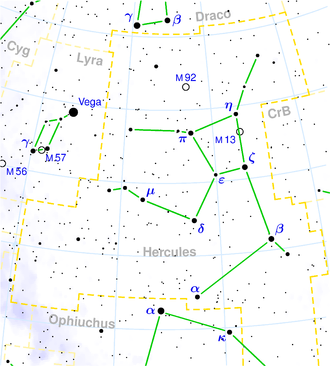NGC 6495
| Galaxy NGC 6495 |
|
|---|---|
|
|
|
| AladinLite | |
| Constellation | Hercules |
|
Position equinox : J2000.0 , epoch : J2000.0 |
|
| Right ascension | 17 h 54 m 50.758 s |
| declination | + 18 ° 19 ′ 36.89 ″ |
| Appearance | |
| Morphological type | E. |
| Brightness (visual) | 12.2 mag |
| Brightness (B-band) | 13.2 mag |
| Angular expansion | 2.0 ′ × 1.8 ′ |
| Position angle | 69 ° |
| Surface brightness | 13.5 mag / arcmin² |
| Physical data | |
| Affiliation | WBL 649 |
| Redshift | 0.010431 ± 0.000060 |
| Radial velocity | 3127 ± 18 km / s |
|
Stroke distance v rad / H 0 |
(147 ± 10) · 10 6 ly (45.0 ± 3.2) Mpc |
| history | |
| discovery | Albert Marth |
| Discovery date | May 11, 1864 |
| Catalog names | |
| NGC 6495 • UGC 11034 • PGC 61091 • CGCG 112-070 • CGCG 113-004 • MCG + 03-45-039 • 2MASX J17545074 + 1819367 • GC 5886 • WISEA J175450.78 + 181936.6 • LDCE 1274 NED004 | |
NGC 6495 is a 12.6 may bright elliptical galaxy from the Hubble type E1 in the constellation Hercules at the northern sky . It is estimated to be 147 million light years from the Milky Way and about 85,000 light years across . Presumably it forms a gravitationally bound galaxy pair together with NGC 6490 . In the same area of the sky are u. a. the galaxies NGC 6500 and NGC 6501 .
The Type Ia supernova SN 1998bp was observed here.
The object was discovered by Albert Marth on May 11, 1864 .
Web links
- NGC 6495. SIMBAD , accessed August 7, 2019 .
- NGC 6495. DSO Browser, accessed August 7, 2016 .
- Auke Slotegraaf : NGC 6495. Deep Sky Observer's Companion, accessed on August 7, 2016 .
